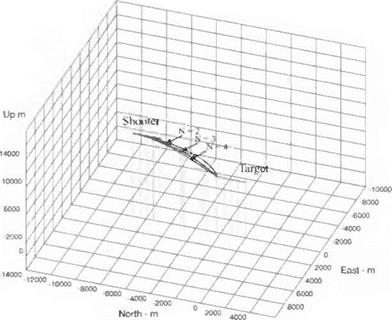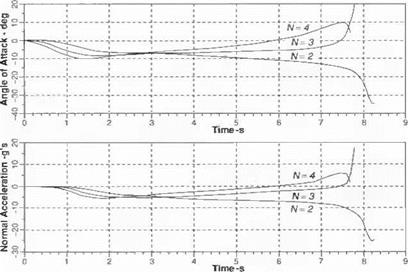Vertical engagement
The second scenario is a shoot-down engagement in the vertical plane. The initial situation is given in Fig. 9.51. Both aircraft cruise at 0.9 Mach, but, because of different altitudes, they do not have the same velocity. As in the horizontal case, we study the sensitivity of the missile performance to the navigation gains N = 2, 3, 4 and compare flight time, Mach number, and miss distance at intercept.
Figure 9.52 shows the vertical engagement of the three cases. In this shoot – down scenario the missile intercepts the target with all three navigation gains (see Table 9.2). The smaller gain values lead to trajectories with less depression because the acceleration command is reduced. This response of the missile acceleration is confirmed by Fig. 9.53. Observe how the angle of attack and the resultant normal acceleration depress down the missile quicker with higher gains. With N = 2 the missile almost overshoots the target, save for a final pull-down effort that exhausts its maneuvering capability. Higher gains exhibit the opposite trend. After the initial downward acceleration the missile has to pull up for the intercept.
This sample simulation of an air-intercept missile highlights several points. Any aerospace vehicle simulation should exhibit a modular structure to mirror the vehicle’s subsystems. With the interfaces clearly defined, several designers can craft the code in parallel, shortening the development time significantly. As these simulations multiply, a library can be maintained and modules exchanged with other applications. I have conserved many resources by reuse of modules and exchange with other organizations.
|
Table 9.2 Summary of vertical engagement
|
|
Fig. 9.52 Vertical missile engagements with navigation gain N = 2,3,4. |
|
|
If you do not have your own modular simulation, you can adopt CADAC as your simulation environment. More than 20 years have been invested in its development and perfection. Although it abides by some stringent FORTRAN conventions, the reward is a code that can easily be modified and shared. Appendix В provides an introduction. More details can be found in the program documentation, made available on the CADAC CD. The vehicle’s modules are embedded in the executive routine CADX. FOR. It handles input/output and integration of state variables. Modules and CADX. FOR compiled together require at run time two input files CADIN. ASC and HEAD. ASC. The first defines the input and the second the output. To inspect these files, go to the CADAC AIM5 folder.
The output, as defined by HEAD. ASC, is written to a TRAJ. BIN file. Now, all of the postprocessing options of CADAC are available. With KPLOT you can display two- and three-dimensional trajectories, as I have done in Figs. 9.49, 9.50, 9.52, and 9.53. Other options allow you to build ASCII files of selected variables, make strip charts, plot footprints, and launch envelopes. If you run multiple stochastic trajectories, you can display histograms, bivariate distributions (error ellipses), and the mean traces of Monte Carlo replications.
After these detailed explanations of a simple pseudo-five-DoF simulation, you should be able to decipher on your own the source code of the more complex short-range air-to-air missile SRAAM5.1 will therefore be brief and refer you to the CADAC CD for the details.













